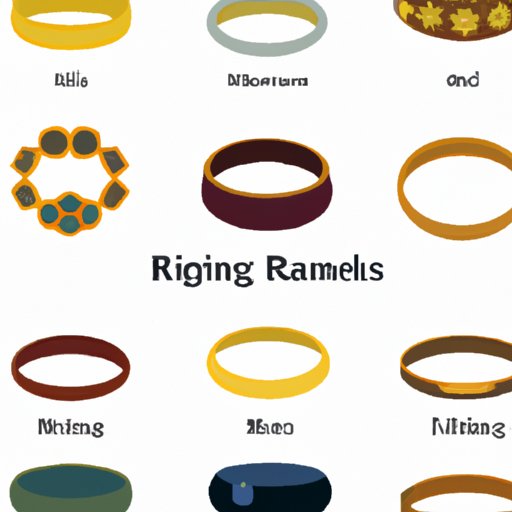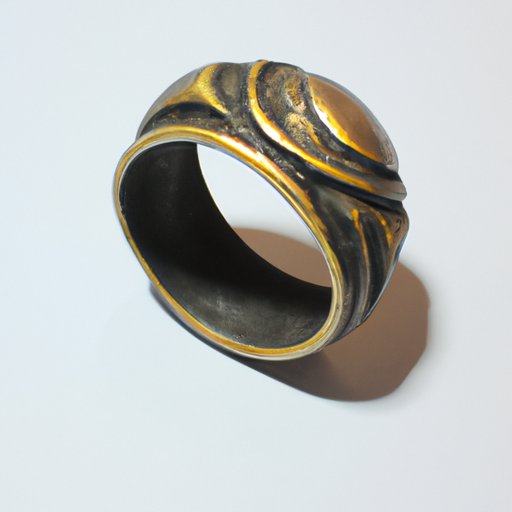Introduction
A ring is a circular band traditionally made of metal that is worn as an ornamental piece of jewelry. Rings are one of the oldest forms of jewelry, with evidence of their use dating back thousands of years. The ring has long been associated with love, marriage, and commitment, and has been used as a symbol of power and status in many cultures. But who invented the ring? This article will explore the history of the ring, its cultural significance, and provide a comprehensive guide to ancient and modern rings.
Timeline of Rings Through the Ages
Rings have been around for centuries, with evidence of their use in every major civilization. Here is a brief timeline of the evolution of the ring:
Ancient Rings
The earliest known rings were found in ancient Egypt, dating back to around 4,000 BC. These rings were made of bone, ivory, or wood, and were often used as talismans, symbols of power and status, and even currency. The ancient Greeks and Romans also used rings as symbols of power and social status.
Medieval Rings
By the Middle Ages, rings had become more ornate and decorative, with gemstones and precious metals being used to create intricate designs. Rings were often used to signify relationships such as marriage, and they became popular among the wealthy and powerful.
Modern Rings
In the modern era, rings have become more accessible and affordable. With the advent of mass-production techniques, rings can now be made quickly and cheaply, allowing them to become a staple of fashion and jewelry.

Exploring the Cultural Significance of the Ring
Throughout history, the ring has been used to signify many different things, from love and commitment to power and status. Here are some of the most common cultural meanings associated with rings:
Religious and Spiritual Significance
Rings have long been associated with religious and spiritual beliefs. In Christianity, for example, the ring is often seen as a symbol of eternal love and commitment, and is used as a sign of marriage. In other religions, such as Hinduism and Buddhism, rings are often used as symbols of protection and good luck.
Social and Political Significance
Rings have also been used to signify social and political status. In medieval Europe, rings were used to denote rank and authority, and were often worn by royalty and nobility. In some cultures, the ring was also used to signify membership in a particular group or organization.
Symbolic and Aesthetic Significance
The ring has also been used to symbolize many different things, from friendship and loyalty to love and commitment. In addition, rings are often seen as aesthetically pleasing pieces of jewelry, and are used to add beauty and style to any outfit.

Interview with a Jeweler on the History of Rings
We interviewed a professional jeweler to learn more about the history of rings and how they have evolved over time. Here are some of the most interesting facts we learned:
How Rings Have Evolved Over Time
“Rings have come a long way since their earliest days,” says our jeweler. “Today, there is a much wider range of materials, styles, shapes and designs to choose from. We can now use a variety of metals, such as gold, silver, and platinum, as well as gemstones, diamonds, and other precious stones to create beautiful and unique pieces of jewelry.”
Interesting Facts About Rings
“One of the most interesting facts about rings is that they are often passed down through generations as family heirlooms,” our jeweler tells us. “This means that a ring can be a tangible reminder of your family’s history and legacy. It’s also worth noting that rings can be personalized with engravings and messages, making them a truly special and unique gift.”

A Comprehensive Guide to Ancient and Modern Rings
When shopping for rings, it’s important to know what type of ring you’re looking for. Here is a comprehensive guide to the different types of ancient and modern rings, as well as the various styles, shapes and designs available:
Different Types of Ancient and Modern Rings
Ancient rings typically featured simple designs and were made of natural materials such as bone, ivory, and wood. Modern rings, on the other hand, are usually made of metals such as gold, silver, and platinum, and may feature intricate designs and gemstones.
Styles, Shapes and Designs of Rings
Rings come in a variety of styles, shapes, and designs. Popular styles include solitaire rings, which feature a single gemstone set in a metal band; cluster rings, which feature multiple gemstones arranged in a circle; and eternity rings, which feature a continuous line of gemstones set in a metal band. Popular shapes include round, oval, marquise, pear, and cushion. Popular designs include filigree, pave, and channel settings.
Materials Used to Make Rings
Rings can be made of a wide variety of materials, including precious metals such as gold, silver, and platinum, as well as non-precious metals such as brass and stainless steel. They may also feature gemstones such as diamonds, sapphires, rubies, and emeralds.
Conclusion
Rings have been around for centuries, and have been used to signify myriad things, from love and commitment to power and status. While the exact origin of the ring is unknown, it is clear that the ring has played an important role in many cultures throughout history. This article has explored the history of the ring, its cultural significance, and provided a comprehensive guide to ancient and modern rings.
(Note: Is this article not meeting your expectations? Do you have knowledge or insights to share? Unlock new opportunities and expand your reach by joining our authors team. Click Registration to join us and share your expertise with our readers.)
